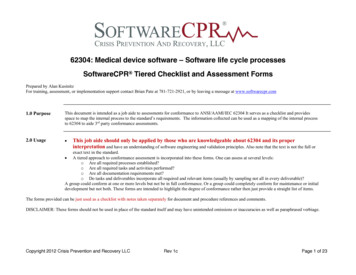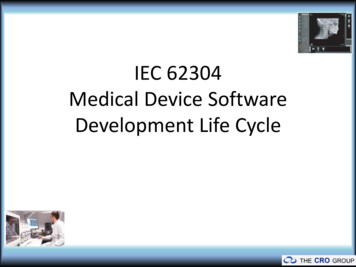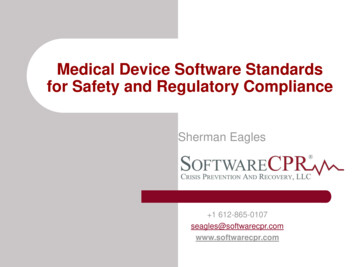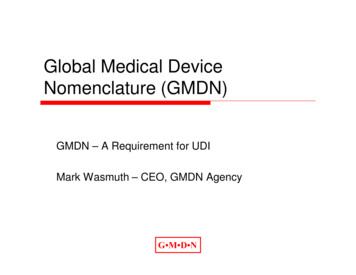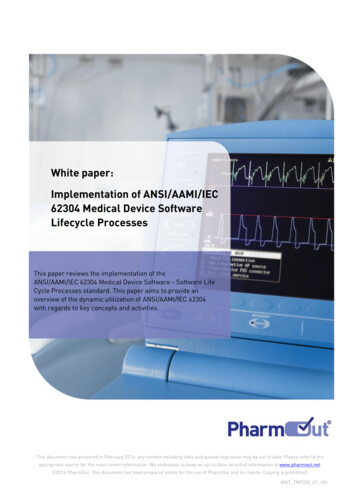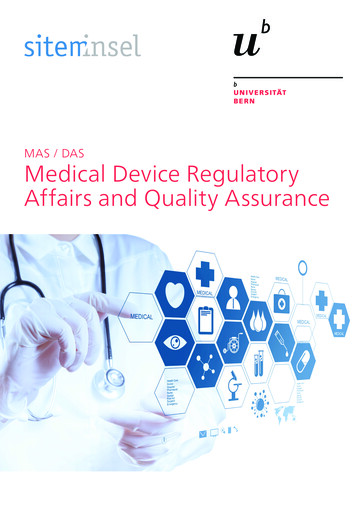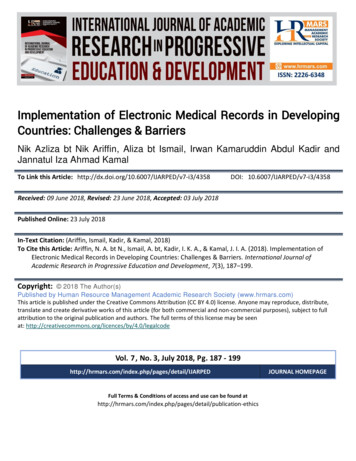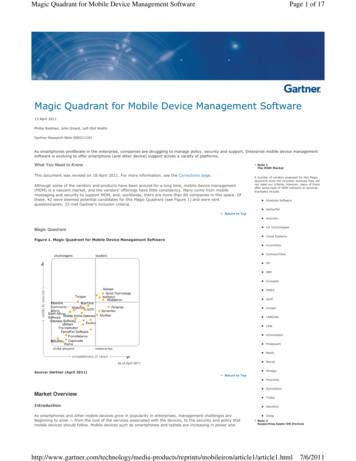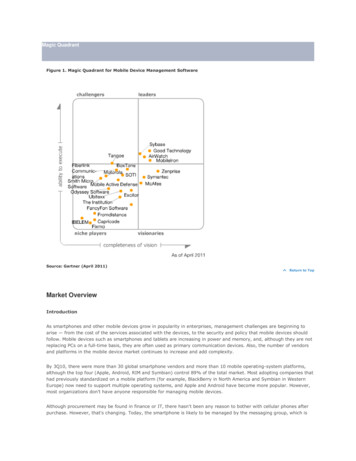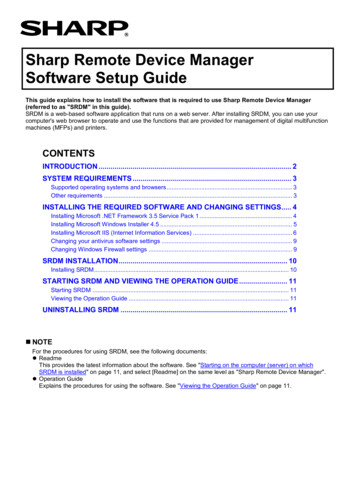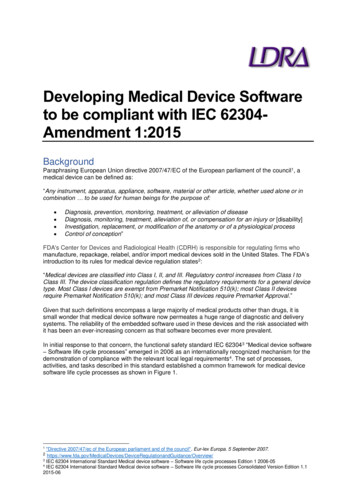
Transcription
Developing Medical Device Softwareto be compliant with IEC 62304Amendment 1:2015BackgroundParaphrasing European Union directive 2007/47/EC of the European parliament of the council1, amedical device can be defined as:“Any instrument, apparatus, appliance, software, material or other article, whether used alone or incombination to be used for human beings for the purpose of: Diagnosis, prevention, monitoring, treatment, or alleviation of diseaseDiagnosis, monitoring, treatment, alleviation of, or compensation for an injury or [disability]Investigation, replacement, or modification of the anatomy or of a physiological processControl of conception”FDA's Center for Devices and Radiological Health (CDRH) is responsible for regulating firms whomanufacture, repackage, relabel, and/or import medical devices sold in the United States. The FDA’sintroduction to its rules for medical device regulation states2:“Medical devices are classified into Class I, II, and III. Regulatory control increases from Class I toClass III. The device classification regulation defines the regulatory requirements for a general devicetype. Most Class I devices are exempt from Premarket Notification 510(k); most Class II devicesrequire Premarket Notification 510(k); and most Class III devices require Premarket Approval.”Given that such definitions encompass a large majority of medical products other than drugs, it issmall wonder that medical device software now permeates a huge range of diagnostic and deliverysystems. The reliability of the embedded software used in these devices and the risk associated withit has been an ever-increasing concern as that software becomes ever more prevalent.In initial response to that concern, the functional safety standard IEC 623043 “Medical device software– Software life cycle processes” emerged in 2006 as an internationally recognized mechanism for thedemonstration of compliance with the relevant local legal requirements4. The set of processes,activities, and tasks described in this standard established a common framework for medical devicesoftware life cycle processes as shown in Figure 1.1"Directive 2007/47/ec of the European parliament and of the council". Eur-lex Europa. 5 September lationandGuidance/Overview/3IEC 62304 International Standard Medical device software – Software life cycle processes Edition 1 2006-054IEC 62304 International Standard Medical device software – Software life cycle processes Consolidated Version Edition 1.12015-062
Figure 1: Overview of software development processes and activities according to IEC 62304:2006 AMD1:20155On June 15, 2015, the International Electrotechnical Commission, IEC, published Amendment 1:2015to the IEC 62304 standard “Medical device software – software life cycle processes”6. Theamendment complements the 1st edition from 2006 by adding and amending various requirements,including those relating to safety classification, the handling of legacy software, and software itemseparation.In practice, for all but the most trivial applications compliance with IEC 62304 can only bedemonstrated efficiently with a comprehensive suite of automated tools. This paper describes the keysoftware development and verification processes of the standard, and shows how automation bothminimizes the cost of development and verification, and provides a sound foundation for an effectivemaintenance system once the product is in the field.Work on the second, updated edition of IEC 62304 is ongoing. The 2nd edition will possibly bepublished in 2018. It seems very likely that the changed requirements included in Amendment 1:2015will be integrated into the updated edition.ClassificationOne of the more significant changes concerns the new risk-based approach to the safetyclassification of medical device software. The previous concept was based exclusively on the severityof the resulting harm. Downgrading of the safety classification of medical device software from C to Bor B to A used to be possible by adopting hardware-based risk mitigation measures external to thesoftware. The new amendment now replaces this concept with safety classification as shown in aIEC 62304:2006/AMD1:2015 Amendment 1 - Medical device software - Software life cycle processes Figure 1 – Overview ofsoftware development PROCESSES and ACTIVITIES6IEC 62304:2006/AMD1:2015 Amendment 1 - Medical device software - Software life cycle processes5
decision tree (Figure 2).
Figure 2: Safety classification according to IEC 62304:2006 AMD1:2015 7The three classes are defined in the standard as follows:Class AThe software system cannot contribute to a hazardous situation, or the software system cancontribute to a hazardous situation which does not result in unacceptable risk after consideration ofrisk control measures external to the software system.Class BThe software system can contribute to a hazardous situation which results in unacceptable risk afterconsideration of risk control measures external to the software system, but the resulting possibleharm is non-serious injury.Class CThe software system can contribute to a hazardous situation which results in unacceptable risk afterconsideration of risk control measures external to the software system, and the resulting possibleharm is death or serious injury.Partitioning of software itemsThe classification assigned to any medical device software has a tremendous impact on the codedevelopment process from planning, developing, testing, and verification through to release andbeyond. It is therefore in the interests of medical device manufacturers to invest the effort to get itIEC 62304:2006/AMD1:2015 Amendment 1 - Medical device software - Software life cycle processes Figure 3 – Assigningsoftware safety classification7
right the first time, minimizing unnecessary overhead by resisting over classification, but alsoavoiding expensive and time-consuming rework resulting from under classification.IEC 62304:2006 AMD1:2015 helps to minimise development overhead by permitting software itemsto be segregated. In doing so, it requires that “The software ARCHITECTURE should promotesegregation of software items that are required for safe operation and should describe the methodsused to ensure effective segregation of those SOFTWARE ITEMS”Amendment 1 clarifies the position on that software segregation by stating that segregation is notrestricted to physical separation, but instead permits “any mechanism that prevents one SOFTWAREITEM from negatively affecting another” suggesting that separation in software is similarly valid.Figure 3: Example of partitioning of software items according to IEC 62304:2006 AMD1:2015 Figure B.1 8Figure 3 shows the example used in the standard. In it, a software system has been designated ClassC. That system can be segregated into one software item to deal with functionality of limited safetyimplications (software item X), and another to handle highly safety critical aspects of the system(software item Y).That principle can be repeated in a hierarchical manner, such that software item Y can itself besegregated into software items W and Z, and so on – always on the basis that no segregatedsoftware item can negatively affect another. At the bottom of the hierarchy, software items such as X,W and Z that are divided no further are defined as software units.Clause 5. Software Development PROCESSIn practice, any company developing medical device software will carry out verification, integrationand system testing on all software regardless of the safety classification, but the depth to which each8IEC 62304:2006/AMD1:2015 Amendment 1 - Medical device software - Software life cycle processes Figure B.1 – Exampleof partitioning of SOFTWARE ITEMS
of those activities is performed varies considerably. Table 1 is based on table A1 of the standard, andgives an overview of what is involved.For example, subclass 5.4.2 of the standard states that “The MANUFACTURER shall document adesign with enough detail to allow correct implementation of each SOFTWARE UNIT.”Reference to Figure 4 shows that it applies only to Class C code.Software Development PROCESS requirements by software safety CLASSClause5.1 Softwaredevelopment planningSub-clauses5.1.1, 5.1.2, 5.1.3, 5.1.6, 5.1.7,5.1.8, 5.1.95.1.5, 5.1.10, 5.1.11,5.1.12Class AClass BClass CXXXXX5.1.45.2 Software requirementsanalysis5.2.1, 5.2.2, 5.2.4, 5.2.5, 5.2.6XXXX5.2.3XX5.3 SoftwareARCHITECTURALdesign5.4 Software detaileddesign5.3.1, 5.3.2, 5.3.3, 5.3.4, 5.3.6XX5.5 SOFTWARE UNITimplementation andverification5.5.15.3.5X5.4.1X5.4.2, 5.4.3, 5.4.4XX5.5.2, 5.5.3, 5.5.5XXXX5.5.45.6 Software integration andintegration testingAll requirements5.7 SOFTWARE SYSTEMtestingAll requirements5.8.1,,5.8.2,5.8.4,5.8.7,5.8.85.8 Software release5.8.3, 5.8.5, 5.8.6,XXXXXXXXXXXXFigure 4: Summary of which software safety classes are assigned to each requirement in the developmentlifecycle requirement, highlighting clause 5.4.2 as an example 9.IEC 62304 is essentially an amalgam of existing best practice in medical device software engineering,and the functional safety principles recommended by the more generic functional safety standard IEC6150810, which has been used as a basis for industry specific interpretations in a host of sectors asdiverse as the rail industry, the process industries, and earth moving equipment manufacture.A process-wide, proven tool suite has been shown to help ensure compliance to such software safetystandards (in addition to security standards) by automating both the analysis of the code from asoftware quality perspective and the required validation and verification work. Equally important, sucha tool suite enables life-cycle transparency and traceability into and throughout the development andverification activities facilitating audits from both internal and external entities.The V diagram in Figure 5 illustrates how tools can help through the software development processdescribed by IEC 62304. The tools also provide critical assistance through the software maintenanceprocess (clause 6) and the risk management process (clause 7). Clause 5 of IEC 62304 details thesoftware development process through eight stages ending in release. Notice that the elements ofClause 5 map to those in Figure 1 and Figure 5.Based on IEC 62304:2006/AMD1:2015 Amendment 1 - Medical device software - Software life cycle processes Table A.1 –Summary of requirements by software safety class10IEC 61508:2010 Functional safety of electrical/electronic/programmable electronic safety-related systems9
Figure 5: Mapping the capabilities of the LDRA tool suite to the guidelines of IEC 62304:2006 AMD1:2015Sub-clause 5.1 Software Development Planning outlines the first objective in the softwaredevelopment process, which is to plan the tasks needed for development of the software in order toreduce risks and communicate procedures and goals to members of the development team.The foundations for an efficient development cycle can be established by using tools that can facilitatestructured requirements definition, such that those requirements can be confirmed as met by meansof automated document (or “artefact”) generation.The preparation of a mechanism to demonstrate that the requirements have been met will involve thedevelopment of detailed plans. A prominent example would be the software verification plan to includetasks to be performed during software verification and their assignment to specific resources.Software Requirements Analysis (Sub-clause 5.2) involves deriving and documenting the softwarerequirements based on the system requirements.Achieving a format that lends itself to bi-directional traceability will help to achieve compliance with thestandard. Bigger projects, perhaps with contributors in geographically diverse locations, are likely tobenefit from an application lifecycle management tool such as IBM Rational DOORS 11, orSiemens Polarion PLM 12. Smaller projects can cope admirably with carefully worded Microsoft Word or Microsoft Excel documents, written to facilitate links up and down the developmentprocess model.This Bidirectional Traceability of Requirements13 (Figure 6) would be easily achieved in an idealworld. But most projects suffer from unexpected changes of requirement imposed by a customer.What is then impacted? Which requirements need re-writing? What elements of the code design?What code needs to be revised? And which parts of the software will require ens.com/13 bidirectional.pdf Bidirectional Requirements Traceability, Linda Westfall12
Figure 6: An Illustration of the principles of Bidirectional TraceabilityRequirements rarely remain unchanged throughout the lifetime of a project, and that can turn themaintenance of a traceability matrix into an administrative nightmare. Furthermore, connectedsystems extend that headache into maintenance phase, requiring revision whenever a vulnerability isexposed.A requirements traceability tool alleviates this concern by automatically maintaining the connectionsbetween requirements, development, and testing artefacts and activities. Any changes in theassociated documents or software code are automatically highlighted such that any tests required tobe revisited can be dealt with accordingly (Figure 7).Figure 7: Automating requirements traceability with the TBmanager component of the LDRA tool suiteSoftware Architectural Design (Sub-clause 5.3) requires the manufacturer to define the majorstructural components of the software, their externally visible properties, and the relationshipsbetween them. Any software component behaviour that can affect other components should bedescribed in the software architecture, such that all software requirements can be implemented by thespecified soft
IEC 62304 is essentially an amalgam of existing best practice in medical device software engineering, and the functional safety principles recommended by the more generic functional safety standard IEC 6150810, which has been used as a basis for industry specific interpretations in a host of sectors as diverse as the rail industry, the process industries, and earth moving equipment manufacture .File Size: 934KBPage Count: 12
